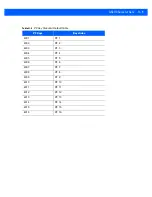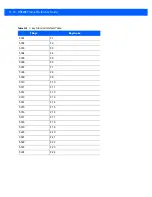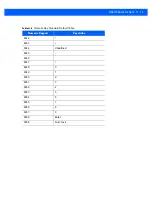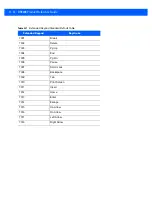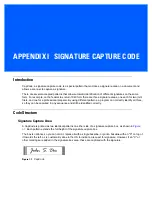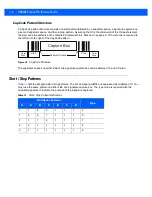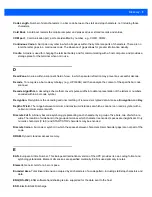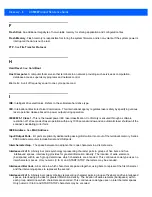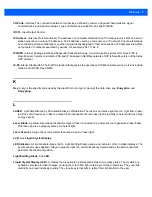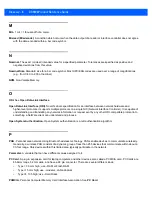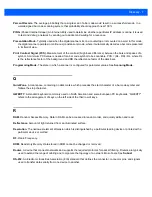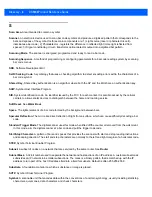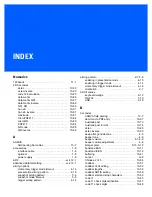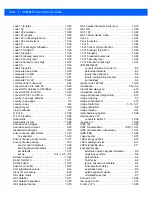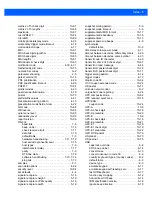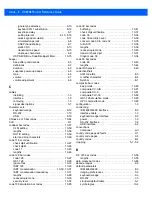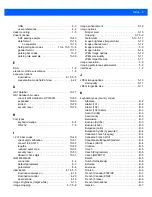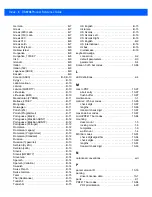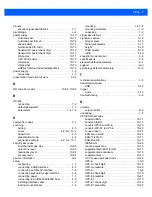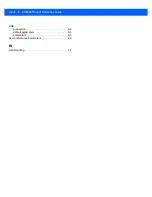
Glossary - 7
Percent Decode.
The average probability that a single scan of a bar code would result in a successful decode. In a
well-designed bar code scanning system, that probability should approach near 100%.
PING.
(Packet Internet Groper) An Internet utility used to determine whether a particular IP address is online. It is used
to test and debug a network by sending out a packet and waiting for a response.
Presentation Mode.
Typically used when the digital scanner sits on a countertop or is mounted on a wall, in this mode,
the digital scanner operates in continuous (constant-on) mode, where it automatically decodes a bar code presented
in its field of view.
Print Contrast Signal (PCS).
Measurement of the contrast (brightness difference) between the bars and spaces of a
symbol. A minimum PCS value is needed for a bar code symbol to be scannable. PCS = (RL - RD) / RL, where RL
is the reflectance factor of the background and RD the reflectance factor of the dark bars.
Programming Mode.
The state in which a scanner is configured for parameter values. See
Scanning Mode
.
Q
Quiet Zone.
A clear space, containing no dark marks, which precedes the start character of a bar code symbol and
follows the stop character.
QWERTY.
A standard keyboard commonly used on North American and some European PC keyboards. “QWERTY”
refers to the arrangement of keys on the left side of the third row of keys.
R
RAM.
Random Access Memory. Data in RAM can be accessed in random order, and quickly written and read.
Reflectance.
Amount of light returned from an illuminated surface.
Resolution.
The narrowest element dimension which is distinguished by a particular reading device or printed with a
particular device or method.
RF.
Radio Frequency.
ROM.
Read-Only Memory. Data stored in ROM cannot be changed or removed.
Router.
A device that connects networks and supports the required protocols for packet filtering. Routers are typically
used to extend the range of cabling and to organize the topology of a network into subnets. See
Subnet
.
RS-232.
An Electronic Industries Association (EIA) standard that defines the connector, connector pins, and signals
used to transfer data serially from one device to another.
Summary of Contents for DS9208
Page 1: ...DS9208 DIGITAL SCANNER PRODUCT REFERENCE GUIDE ...
Page 2: ......
Page 3: ...DS9208 PRODUCT REFERENCE GUIDE 72E 139635 06 Revision A May 2015 ...
Page 6: ...iv DS9208 Product Reference Guide ...
Page 30: ...1 10 DS9208 Product Reference Guide Figure 1 10 Locking Mount Bracket Template 54 mm 49 mm ...
Page 46: ...3 8 DS9208 Product Reference Guide ...
Page 110: ...5 20 DS9208 Product Reference Guide ...
Page 140: ...6 30 DS9208 Product Reference Guide ...
Page 164: ...7 24 DS9208 Product Reference Guide ...
Page 288: ...10 98 DS9208 Product Reference Guide ...
Page 292: ...12 2 DS9208 Product Reference Guide ...
Page 348: ...A 12 DS9208 Product Reference Guide ...
Page 388: ...D 10 DS9208 Product Reference Guide ...
Page 396: ...E 8 DS9208 Product Reference Guide ...
Page 397: ...APPENDIX F SAMPLE BAR CODES Code 39 UPC EAN UPC A 100 123ABC 0 12345 67890 5 ...
Page 400: ...F 4 DS9208 Product Reference Guide QR Code Han Xin US Postnet UK Postal ...
Page 438: ......
Page 439: ......

